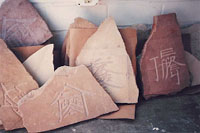| |
 New
English Calligraphy Classroom New
English Calligraphy Classroom
1994-1996
Mixed media installation: desk/chair sets, copy and tracing
books, brushes, ink, video.
The goal of this installation is to simulate a school-like
classroom in a gallery or museum space. Desks are arranged
with small containers of ink, brushes and a copybook that
instructs on the basic principles of the artist's New English
Calligraphy. A video produced by the artist and entitled
"Elementary Square word Calligraphy Instruction,"
plays on a monitor in the room luring the audience into
participating. Once they sit and take up the brush, learning
of the New English Calligraphy begins. Developed by the
artist, New English Calligraphy intends to fuse written
English with written Chinese. English letters are arranged
in square word format to appear like Chinese characters,
yet remain legible to the English speaker. When people try
to recognize and write these words, some of the thinking
patterns that have been ingrained in them since they learned
to read are challenged. It is the artists' belief that people
must have their routine thinking attacked in this way. While
undergoing this process of estrangement and re-familiarizing
with one's written language, one can be reminded that the
sensation of distance between other systems is self-induced.
 New
English Calligraphy Stones New
English Calligraphy Stones
1996
Stone blocks with carved New English Calligraphy surnames,
rubbings from the blocks.
This work is a part of the New English Calligraphy project.
It employs the traditional Chinese printing technique of
rubbing from stone. Flat-faced stones are carved with the
New English Calligraphy characters, either words or surnames.
Rubbings are made from these stones and displayed either
by themselves or in other installations such as Your Surname
Please, or New English Calligraphy Classroom.
 Your
surname Please Your
surname Please
1998
Mixed media installation: panels of calligraphy, computers,
printers, desks and chairs.
This work was made originally for the island of Las Palmas,
Spain. The surnames of the island's inhabitants were written
using the alphabet of New English Calligraphy and displayed
on a wall. The names were scanned into a computer and the
audience was invited to find their surname in its database,
print out a copy of their surname in New English Calligraphy
square word form and take it home.
 New
English Calligraphy Texts New
English Calligraphy Texts
1998
Rice paper, Chinese ink.
This piece uses a traditional form of Chinese Calligraphy
Art to display a western piece of writing. The New English
Calligraphy alphabet is us to create a piece that is Chinese
in appearance, yet understandable to the western viewer.
In essence, these texts portray the language or written
English in a Chinese form that has never before graced the
pages of English text. Poems by Ezra Pound, William Carlos
Williams, Robert Frost and others have been rendered along
with logos, quotations from Chairman Mao Tsetung and the
titles of exhibitions, such as this one for the "Third
Asia Pacific Triennial of Contemporary Art".
|
Photo
Gallery
|
|
|
|
 |
|
|
|